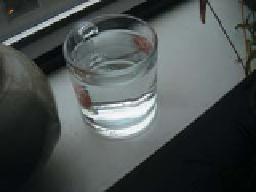Graphics Reference
In-Depth Information
If you are reading this indoors, then most of the light that you are seeing has
been reflected multiple times. You can verify this by standing in an empty room
with painted walls, illuminated by a single bulb. If you place a black occluder
next to the bulb, some portion of the room will be “in shadow,” but nonetheless
remains remarkably bright. The importance of this multiply reflected light is not
well measured by computing energies, because of the logarithmic sensitivity of
the eye: Even comparatively dark areas are easy for us to see; these darker areas
are ones where indirect illumination has taken multiple attenuating bounces. Even
though little energy from them is reaching the eye, we can easily detect variations
on surfaces, such as the pattern on a carpet in a dark corner of a room.
Figure 29.13: Under diffuse light,
the caustics disappear.
These variations in dark regions can, however, be lost in the presence of other
light. Figure 29.16 shows how the view through a car window can be masked by
reflected light from papers on the dashboard.
Keep these examples in mind as you read about rendering algorithms, and ask
yourself which of them each algorithm is capable of replicating.
The key ideas in this chapter are the reflection equation and the transport equa-
tion, which combine to form the rendering equation, and the measurement equa-
tion, which is added as a final step in the process of image formation. Equally
important is the notion of dividing various phenomena into “impulse” and “finite”
pieces. This division applies to the BSDF, where impulses include mirror reflec-
tion and Snell's-law refraction, and to luminaires, where point lights act as a kind
of impulse in the illumination. Such impulses require that we regard integrals with
a skeptical eye, because integrals of finite pieces can be reliably estimated with
Monte Carlo methods, as we'll see in the next few chapters, while those involving
impulses must be treated separately.
The physical formulation of light transport is central to rendering, but it's also
worth understanding the
phenomena
, that is, the human-perceived aspects, of light
transport. The tiny “rainbows” cast by a chandelier on the walls of a well-lit room
are insignificant in the total illumination by physical measures, but to a person
sitting in the room, they are important characteristics that attract attention. Under-
standing these phenomena helps us understand which aspects of physical light
transport may have greater impacts on the perceived correctness of an image.
Figure
29.14:
Distorted
reflec-
tions.
Figure 29.15: Refraction of light
by water can break up spatial
continuity.
Exercise 29.1:
Show that if you have the ray-casting function
R
, then you can
build a
visibility function
V
:
0, 1, where
V
(
P
,
Q
)
is 1 if all points
of the line segment from
P
to
Q
that are strictly between the ends are in empty
space, and is 0 otherwise. Informally,
V
(
P
.
Q
)
is 1 when
Q
is visible from
P
(and
vice versa). Note that according to our definition,
V
(
P
,
P
)
is always 1. You may
assume that you have a mechanism for perfect equality testing of points.
M
×
M
→
Figure 29.16: The reflections
from the dashboard obscure the
view through the window.







